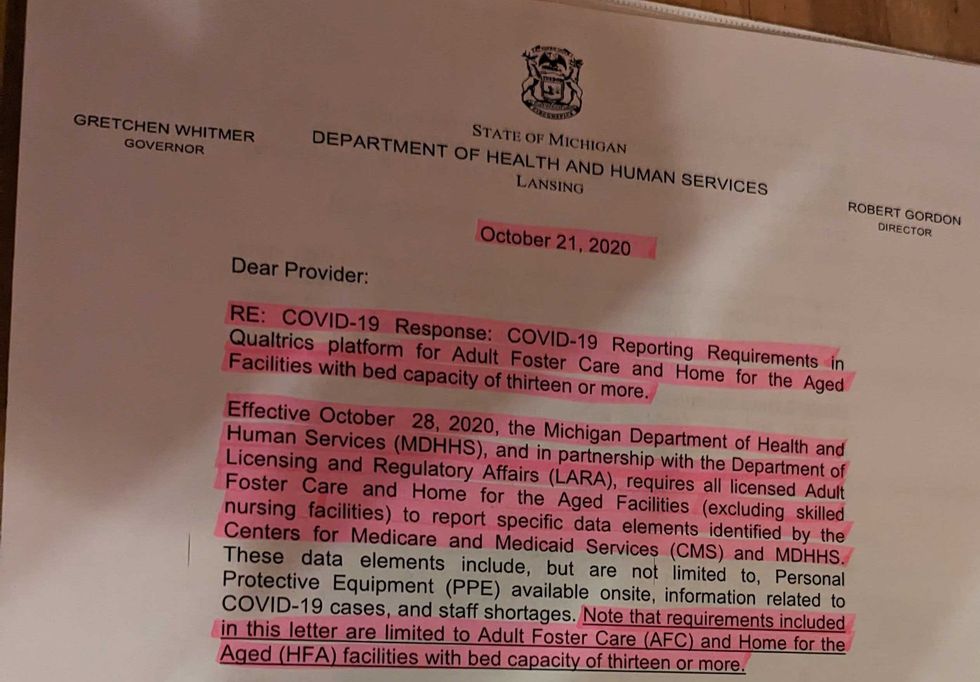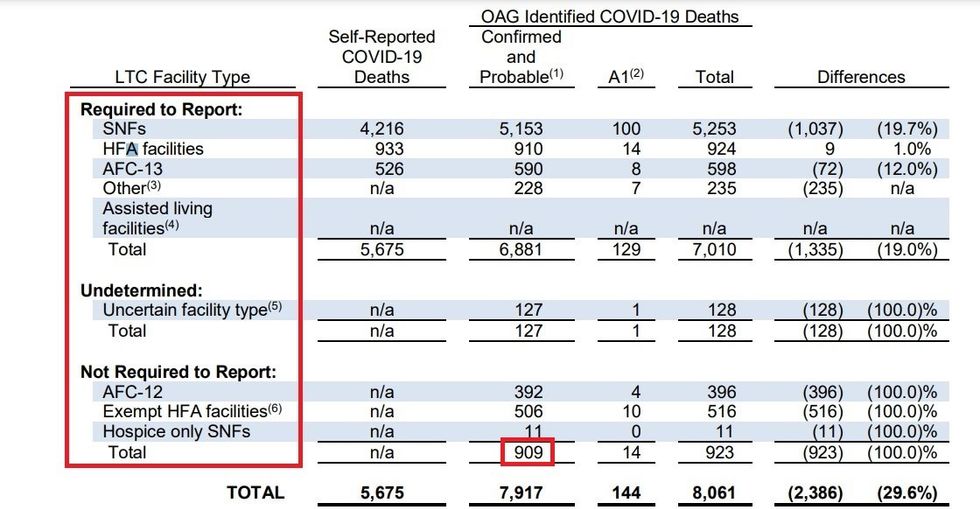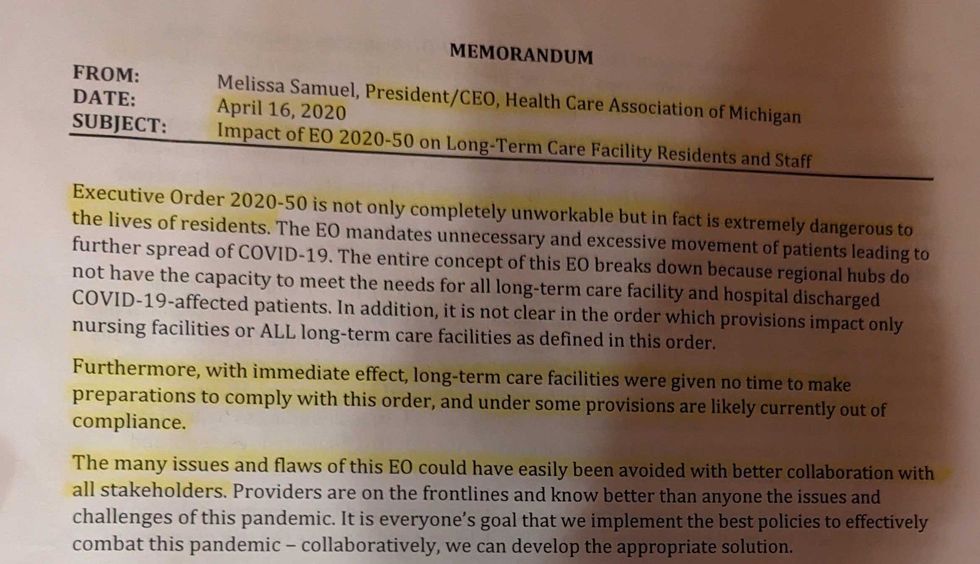
Nes/Getty Images stock photo

During the COVID scare of 2020, Michigan was one of a handful of states that drew national attention because of its strict and seemingly capricious government restrictions. That year, Gov. Gretchen Whitmer followed the example of other Democrat governors like Andrew Cuomo in New York and implemented onerous lockdown measures that prevented young, healthy people from going to work or even buying seeds for their gardens and forced some of the infected into long-term care facilities designed to serve the elderly and the vulnerable.
According to the New York Times, the state of Michigan recorded over 3 million COVID cases and nearly 39,000 "deaths due to" COVID. However, the exact number of COVID deaths in the state's long-term care facilities, otherwise known as LTCs, is much more difficult to ascertain.
By July 2021, 18 months after the virus first infiltrated the state, Michigan reported that 5,740 residents and staff members affiliated with LTCs had died of COVID. But some looking into the data, including Michigan Auditor General Doug Ringler, came to much different conclusions. In fact, Ringler later issued an audit claiming that the number of COVID deaths that could be "linked to an LTC facility" was actually 8,061 — nearly 30% higher than the total recognized by the Michigan Department of Health and Human Services.
Joe LeBlanc, an award-winning former director of an assisted living facility in Michigan and a former board member of the state lobbying group Michigan Center for Assisted Living, is a field expert who likewise doubts the MDHHS' number. He recently gave several interviews to Blaze News to explain how, in his view, officials managed to hide the true number of LTC-related COVID deaths and why accurate numbers still matter today, nearly four years after most of those deaths occurred.
According to LeBlanc, "confusing" and arcane terminology associated with long-term care facilities has led officials to calculate the overall total of Michigan LTC COVID deaths in different ways.
Though the general public often uses terms such as "nursing home" and "assisted living facility" interchangeably, LeBlanc explained important differences between them. Not only do states treat nursing homes and assisted living facilities differently, but assisted living facilities can be further divided into three distinct groups: homes for the aged, adult foster care homes, and exempt communities.
Michigan defines homes for the aged as facilities where 21 or more unrelated people ages 55 and older reside, enjoying basic independence but with the comfort and peace of mind of having "supervised personal care" available to them.
Adult foster care homes provide much more involved "supervision and protection" and are open to any adult with physical or mental disabilities, regardless of age. Such facilities are smaller than homes for the aged, housing anywhere from three to 20 unrelated people.
Exempt communities compose the largest number of assisted living facilities in the state, LeBlanc claimed. While exempt communities "follow pretty much all the same regulations," they are not licensed by the state and therefore have some freedom to enact and enforce their own policies and procedures, he said.
LeBlanc spent nine years as the director of an exempt LTC community in Grand Rapids. He told Blaze News that because of his facility's relative independence, he was able to dodge most of the state's oversight in 2020 and protect his residents. As a result, his facility did not have a single COVID-related death, he claimed.
"We took active measures to defend ourselves from the garbage directed out of Lansing," he claimed. "... I can't even imagine how we would have survived by locking these people out for over a year."
As LeBlanc does not want to involve his former workplace or its owners in his criticism of state leadership during COVID, Blaze News has opted not to share its name here.
The differences between these LTCs played a significant role in COVID data. In tallying the COVID numbers, the MDHHS included data from some LTCs but not others without ever fully explaining why, LeBlanc claimed.
Directives and statements issued from various state leaders support LeBlanc's assertion. An MDHHS letter dated October 21, 2020, and bearing Whitmer's name on the letterhead explained the "COVID-19 Reporting Requirements" only for homes for the aged and adult foster care facilities with a bed capacity of thirteen or more.
Lest anyone mistake which facilities would be required to submit COVID data, the letter later clarified: "Note that requirements included in this letter are limited to Adult Foster Care (AFC) and Home for the Aged (HFA) facilities with bed capacity of thirteen or more," it reiterated.

Rather than underline that statement for emphasis, the author of the letter ought to have been more careful with the syntax. As homes for aged, by definition, always have at least 21 beds, the qualifying phrase "with bed capacity of thirteen or more" applies only to adult foster care facilities, which have between three and 20 beds.
An audit from the Office of Auditor General Doug Ringler issued in January 2022 confirms that the following LTC facilities were "not required to report" COVID deaths: adult foster care homes with 12 or fewer residents, certain homes for the aged, and hospice-only nursing homes.
Thus, the only facilities required to report were most nursing homes, homes for the aged, and a few hundred of the more than 4,700 adult foster care facilities open at the time. LeBlanc estimated to Blaze News that the facilities required to report represent just 60% of the total number of LTCs in the state, and the auditor general's data suggests that the MDHHS' reporting requirements left more than 900 COVID deaths off the LTCs' overall total.

Those 909 deaths alone account for about 40% of the discrepancy between the MDHHS' total of 5,740 and the OAG's total of 8,061. The other 60% relates mainly to differences in reporting from skilled nursing homes, data regarding facility type, and death certificate information.
Elizabeth Hertel, who was named the director of the Michigan Department of Health and Human Services three years ago, did not deny excluding many LTC facilities from official COVID reporting. In fact, she claimed that the auditor general's incorporation of all LTC data was one of the reasons his audit's numbers were inaccurate.
In a letter incorrectly dated January 2021 and issued just days before Ringler's January 2022 audit was released, Hertel wrote that the "data table [pictured above] is misleading and appears to suggest that there was a nearly 30% underreporting, when almost half of this difference can be attributed to facilities not subject to reporting requirements" (emphasis Hertel's).
"At a minimum, this section should be presented in two tables—one with facilities subject to reporting and one with those who were not," she added.
Hertel also indicated that CDC guidelines and a request from the Michigan legislature helped shape these reporting requirements and that her department merely followed their recommendations.
Ringler stood by the his office's findings but stopped short of accusing the MDHHS of underreporting LTC COVID deaths. "We knew that the department wasn’t tracking all the ones that we reflected in our letter," he said at a legislative hearing held to discuss the audit. "So we didn’t feel the word 'under-report' was fair. We cited it as a difference."
It is important to note that just because a COVID death was not included in the LTC totals does not mean it was not counted at all. LTCs are primarily focused on helping residents with personal needs such as "bathing, dressing, toileting, meds, showering," LeBlanc said. They are not equipped or staffed properly to provide much medical assistance beyond basic nursing care.
During lockdowns, Michigan LTC residents who developed moderate or severe cases of COVID were immediately transferred to area hospitals for treatment. Those former residents with a confirmed or probable case of COVID who died at a hospital were likely included in the numbers the hospital reported to the state.
MDHHS Director Hertel indicated as much in her January 2022 letter. Hertel claimed that the CDC defined an LTC COVID death as one in which the resident died "in the facility" or in any other location in which the resident was "transferred to receive treatment," so long as the resident was expected to return to the LTC at a later time. Those who were "not expected to return" to their LTCs — perhaps because their cases were so far advanced that they were transferred to hospice care — were "excluded" from LTC counts, she said.
Unfortunately, it's difficult to corroborate many of the official claims about COVID since some of the LTC COVID reporting is no longer available. According to emails viewed by Blaze News, in June 2022, independent Michigan journalist Charlie LeDuff contacted the MDHHS and asked for help locating the state website page with LTC COVID data from May until October 2020. A representative replied that the agency "no longer ha[d] access to" the original reports submitted by individual facilities during that time period because it had since switched from using the Survey Gizmo platform to Qualtrics.
"When facilities transitioned from self-led reporting in Survey Gizmo to MDHHS directed and required reporting in Qualtrics they were required to complete a registration," the representative wrote to LeDuff. "During that registration period they supplied their historical data. So, the first data entry for each of these facilities is reflective of the historical data (January 2020 – date of registration)."
The representative also assured LeDuff that "the data migrated over and is included in the totals."
The MDHHS did not respond to Blaze News' request for comment.
As often as state leaders have claimed that many of their COVID-related lockdown decisions were made early in 2020 when the threat was not well understood, the dangers COVID posed to the elderly in particular were clear almost from the beginning. As early as March of that year, the Mayo Clinic News Network, citing the CDC, issued a report warning that adults "over 65 are more at risk of getting seriously ill from COVID-19."
Despite early signs that the elderly required advanced protection from COVID, Gov. Whitmer issued an executive order on April 15, 2020, prohibiting LTCs from denying "admission or readmission of a resident" who had tested positive, even as the EO recognized that the virus posed "a particularly dire threat to the health and safety of both residents and employees of long-term care facilities."
Nursing home owners intuited immediately that Whitmer's EO would almost certainly lead to more nursing home casualties. In a memorandum dated April 16, one day after Whitmer's EO, Melissa Samuel, the president and CEO of Health Care Association of Michigan — a major LTC lobbying group — called it "extremely dangerous to the lives of residents" and "completely unworkable."

Whitmer later amended her order to create 21 "regional hubs," nursing homes scattered throughout the state that had designated COVID wings. Despite some reluctance, the owners of these hubs soon began admitting COVID-positive patients into their facilities, almost certainly introducing the virus to buildings and people with otherwise little or no exposure to it.
By October 2020, COVID nursing home deaths continued to climb, and Michigan government leaders and nursing home owners began to panic, the officials for supporting Whitmer's apparently disastrous executive order and the owners for following it. By the end of the month, the Republican-controlled legislature had passed and Whitmer had signed the Pandemic Health Care Immunity Act, which shielded LTCs from liability lawsuits during a pandemic except in cases of gross negligence or other "willful misconduct."
Nursing home owners affiliated with Health Care Association of Michigan strongly supported the bill. CEO Samuel claimed it offered "limited immunity policies to ensure that providers and caregivers were not punished for following the best practices as issued by state and federal governments at the time."
Craig Mauger of the Detroit News has been carefully covering the COVID response in the state of Michigan for years. According to his reporting, the Health Care Association of Michigan PAC significantly increased its political donations at the time state lawmakers were debating the LTC immunity bill — and just before the contentious 2020 election.
While the HCAM PAC donated $32,250 to various campaign coffers in the first eight months of 2020, it donated more than double that amount — $64,750 — in the following two months, Mauger reported.
Samuel defended the donation increases in 2020 as a "healthy" means of participating in the democratic process. "Our membership programs are part of being a healthy, successful statewide membership association, and that includes an active campaign fundraising program," she insisted. Samuel did not respond to Blaze News' request for comment.
Reports indicate that the HCAM PAC had the means to be generous in the latter half of 2020. According to data collected by Transparency USA, the PAC received a staggering $160,000 in contributions during quarter three of 2020, the highest of any quarter in the past six years. The most the PAC had received in any quarter in the three years prior was $60,000.
Since 2020, the PAC has seen a steady increase in donations. In the second quarter of 2022, it received $120,000, a respectable amount, to be sure, but far short of the high mark of $160,000. The PAC's top two payees are both Republican entities: the House Republican Campaign Committee ($139,500) and the Senate Republican Campaign Committee ($129,000). The next three payees are all Democrats, though they have received just a fraction of the donations given to their Republican counterparts: the Michigan House Democratic Fund ($48,000), Gretchen Whitmer ($46,700), and the Michigan Senate Democratic Fund ($43,500).
Several months after Whitmer's EO had proven to be a failure and the Pandemic Health Care Immunity Act had been well ratified by law and heraldry, state Attorney General Dana Nessel announced that her office would not investigate Whitmer for her decisions regarding COVID and nursing homes. "I see no evidence ... to suggest that Governor Whitmer’s efforts to contain COVID-19 in Michigan’s nursing homes resulted in increased deaths," she wrote to state Senator Jim Runestad and other Republicans in March 2021.
Nessel also used the announcement as an opportunity to go on offense, claiming that those who demanded an investigation on behalf of deceased LTC residents and their loved ones were merely launching a thinly evidenced "political attack." "I appreciate that you and your colleagues have policy disagreements with Governor Whitmer’s response to COVID-19," she told Runestad. "But an investigation by my office is not the mechanism to resolve those disagreements.
"You have provided insufficient indicia that any law has been violated and thus no investigation is warranted at this time."
As vociferously as current MDHHS Director Elizabeth Hertel has defended her office's LTC COVID data, she was not actually in charge of the department when Whitmer imposed the executive order forcing some nursing homes to accept COVID-positive patients. Prior to Hertel's nomination in January 2021, her predecessor, Robert Gordon, resigned unexpectedly — and agreed to a handsome $155,000 severance package in exchange for his silence about many COVID-related issues.
State Republicans immediately cried foul, claiming that Gordon's separation agreement with the state was little more than a "hush money contract." "It’s the agreement about keeping all information tight-lipped, and perhaps even promulgating a lie about what happened, that’s really troubling," claimed state Sen. Ed McBroom.
Whitmer countered that such separation agreements were common practice and insisted that "there were not any improprieties with Director Gordon's work." "Robert Gordon and his team were an incredibly important part of our response [to COVID] and I appreciated his service to our state," she said.
True to his agreement, Gordon has said little about high-level state decisions regarding COVID, though he did later share that Whitmer had asked him to resign because she wanted the MDHHS to go in a "new direction." "I didn't leave the job in the way that I wanted to, but I think I served in the way that I wanted to," he told the state legislature a few months after he left the MDHHS.
"When I reflect and when I think back on my service, I am very proud of my service. I have no regrets about serving Gov. Whitmer. I have no regrets about the advice I gave."
Nine months after he resigned as director of the Michigan Department of Health and Human Services, he was tapped by the Biden administration to serve as the assistant secretary for financial resources for the federal Department of Health and Human Services. He was confirmed, but a link to his government bio is not currently working.
Blaze News sent multiple different emails to Gordon seeking comment, but each email was automatically labeled spam and returned unanswered.
Like others in the long-term care industry, Joe LeBlanc is frustrated that officials at the facility and state levels have never been held to account for their decisions during COVID, especially those pertaining to the elderly, a population that too often goes ignored.
"Seniors don't sell papers, but they're worth 90% of all medical expenses," he recently wrote to Blaze News. "Throughout history, our elders have been valued most. Now they're a $ amount, and they realize it too."
LeBlanc explained that he hopes that once more people understand how officials used obfuscation and linguistic tricks to lowball LTC COVID death totals, they'll become as incensed as he is and demand answers. "They're covering their own a**es," he alleged to Blaze News.
"That's the frustrating part."
Like Blaze News? Bypass the censors, sign up for our newsletters, and get stories like this direct to your inbox. Sign up here!